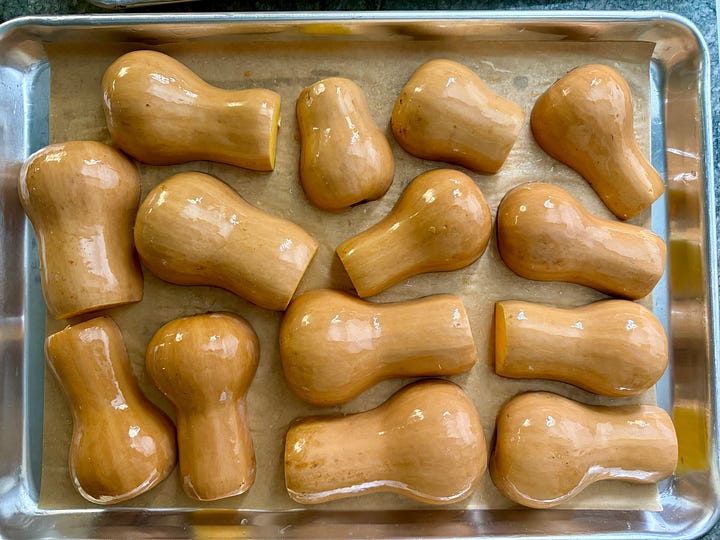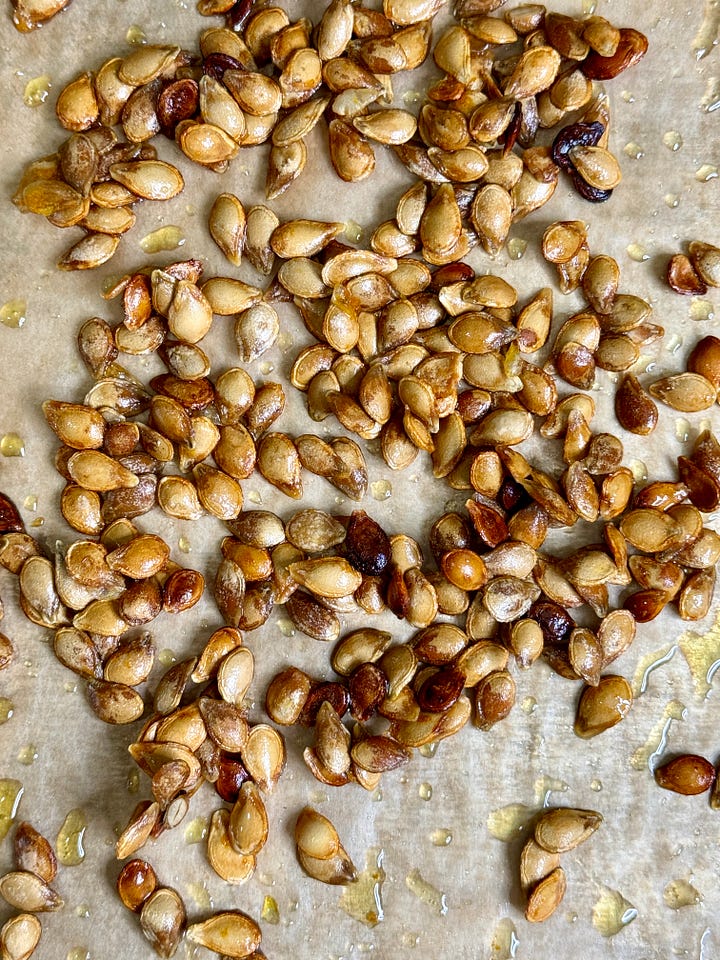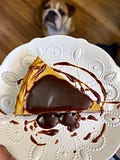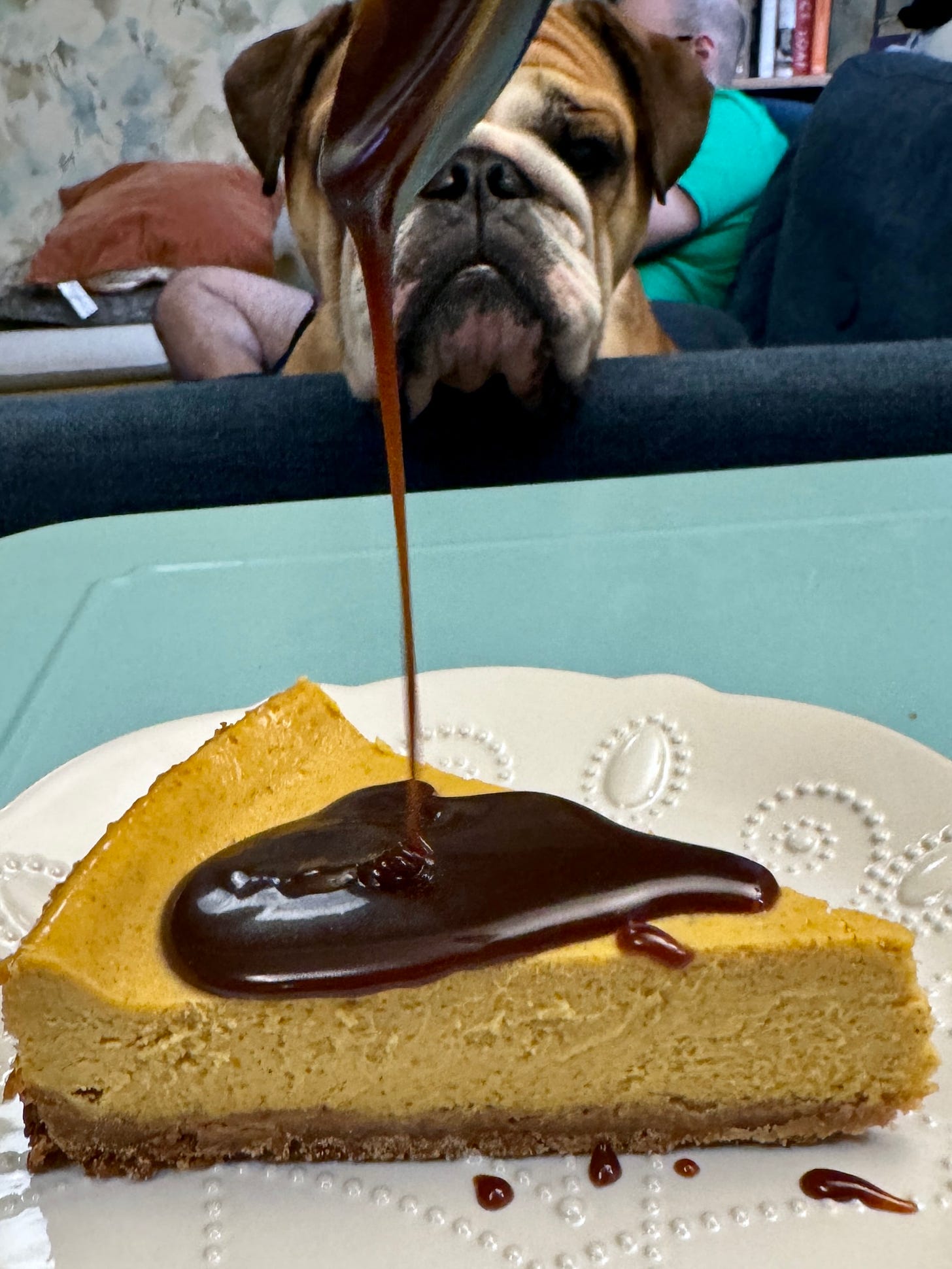That whole mommy-brain thing is very real. You know I know my way around Whole Foods—I typically power through there in minutes. But yesterday, I went to the grocery store and spent an hour gathering ingredients for two recipes. I can remember exactly how many feedings and diaper changes the baby had in the past 24 hours, but even with a list in my notes app, I'd forget what I needed by the time I looked up from my phone. I stood before the chilies for minutes, completely spacing on what peppers/how many peppers/why am I here??? When I finally reached for the serranos, half my pumpkin spice latte ran down my coat and dress. Even without a baby latched to me, I’m always covered in milk.
The biggest sadness was losing that PSL. I never had one before two weeks ago, and now I’m freaking hooked. That hit of sugar, spice, and caffeine is the only joy left in my life, and I don’t understand all the hate it gets. It’s just chai, but coffee, and with a whole lot more cinnamon. Or maybe my new appreciation for it is another side effect of mommy brain? I will report back if I have the sudden urge to take a family photo in front of fall leaves in matching beige sweaters. (I am seriously considering putting the baby in a hollowed-out pumpkin.) Before I get there, let’s turn my newfound love of the PSL into a Pumpkin Spice Latte Cheesecake.
shameless self-promo break
My book baby is due soon (Halloween!), but I have been so busy/sleep-deprived/ covered in spit that I genuinely keep forgetting about it. It’s probably the best thing for my mental health; otherwise, I’d be panicking over the thought of it. Thankfully, my editor, Tom, is stressing enough for two. Please go preorder, if not for me, then for Tom! This book exists because of him. Tom saw my outline, believed in it, and convinced Knopf to give me the advance I needed to make it happen. He let me make the book exactly how I wanted to, which is something that never happens with first-time authors. Tom’s the best, so please help #savetomsjob
PS: The East Coast dates for my book tour are now available, so get your tickets, and I’ll see you on the road! More seats have been added, so if you checked earlier and the event you wanted to attend was sold out, go check again!
is pumpkin a squash?
Should it be called Squash Spice Latte (or is that just my new Spice Girl name)? The only difference I see between pumpkins and winter squash is their shape. Pumpkins are round, while winter squash comes in all sizes and shapes. They cook the same, are similarly sweet and starchy, and are all called pumpkins in Australia. There’s a podcast all about them that I haven’t had the time to listen to. Someone check it out and fill me in. Anyway, whenever I make any pumpkin dessert (pie/cake/ice cream) I reach for honeynut squash. Honeynut squash are the hot new(ish) squash in town. They look like mini butternut squash, but are super concentrated in flavor, extra sweet, and decadently creamy. If you can’t find them, any winter squash can step in. I particularly like kabocha and red kuri.


Applying dry heat is the easiest way to go from dense, hard squash to smooth puree. Boiling or steaming squash can often leach out its flavor and make it watery (with the exception of starchy kabocha, which gets super fluffy when steamed). Much like Fall Grilling Advocate, Carla Lalli Music, Ham loves to grill in the fall, and I always roast squash on the dying coals after he’s done. If you want to give it a go, just prick your squash all over with a cake tester or metal skewer, wrap it in foil, then bury it in the cooling embers. After you dig up your packs from the ashes, you’ll be left with the tender and smoky squash flesh ready to puree.
More often, I roast squash in the oven. The easiest and best way is to roast them whole. This keeps all the flavor and moisture locked in. Plus, it’s a cinch to break down the squash once it’s softened. Prick them all over, place on a sheet tray or roasting pan, and cover in foil. Roast at 350F until easily pricked with a cake tester or skewer. The one downside to this method is that it takes a long time. To speed things up, split the squash in half, scoop out the seeds, and place cut side down on a sheet tray. Lightly rub the skins with oil to promote even cooking, then roast until tender.
seed segue
Did you know the most searched food in October is pumpkin seeds? I first learned about algorithms and SEO when I worked at Serious Eats. A lot of it is obvious: an uptick in searches for turkey in November, cookies in December, hot dogs in July. But the number of people looking for recipes on how to roast pumpkin seeds in October is honestly shocking. Don’t you just roast ‘em? Well, I was wrong. I posted a video roasting pumpkin seeds a couple of years ago and thanks to your comments I learned the secret to crisp, light, and perfectly salted pumpkin seeds. You’ve got to boil them first! It’s a gamechanger!


First, put all your pumpkin/squash guts in a big bowl of water. Use your hands to rub the seeds off the stringy bits. Most of the seeds will float to the surface, and you can use a fine mesh strainer to scoop them off. Strain away the water and pick through to get the rest.
Next, boil the seeds in heavily salted water until tender. I like it pretty salty, so I use 1 tablespoon of salt per quart of water and boil it for 10 minutes.
Finally, strain, toss in oil and seasonings of choice, and roast at 350F until crunchy, about 20 minutes.
get to the cheesecake already!
I hate baking in a water bath with springform pans. I’ve tried all the hacks, with various brands and styles of pan, wrapped layers of foil or plastic or both. At best, the crust is only a little soggy. At worst, it’s utter mush. When first developing this recipe, I tried baking it in a standard cake pan, thinking I could flip it out. Not only did the top get wrecked, but the crust stuck to the pan's bottom.
Then, I found a cheesecake recipe by King Arthur that skips the water bath entirely. Instead, the cheesecake is baked only until the edges are set. While the middle is still wiggly, the oven is turned off and propped open to allow the cheesecake to finish cooking in gentle heat. When I tried this method, the cheesecake was tender and evenly cooked, but had some gnarly cracks. And you know what, I’m good with it. Why are we so afraid of cracked cheesecakes? This cheesecake was rich and smooth with a snappy crust. No water bath, and more importantly, no soggy bottom. This is how I’m gonna cheesecake now. Maybe it’s not picture-perfect, but it tastes freaking epic cause that crust is so damn crisp.
FYI
The crust has a touch of maple syrup. When that liquid sweetener gets with the melted butter and graham crumbs, it will look broken. Don’t panic! It will all absorb when baked and become so brown, so nutty, and so crisp. The maple makes this crust magic, and I will be baking trays of just crust as Christmas cookies this year.
Don’t feel like roasting squash? I don’t blame you. Feel free to crack open a can of pumpkin puree instead.
If you’ve got pumpkin spice or apple pie spice, use 1 tablespoon of that in place of the other spices.
Room temperature ingredients are especially important when making any cheesecake for two key reasons: First, it allows everything to combine evenly with minimal mixing. Less time blending the ingredients means less air will be incorporated into the batter. Air is cheesecake’s enemy. It will make the mix puff and fall when baked, leading to a dry, bubbly interior and deep cracks. (Some cracks are okay, but let’s not go crazy). Secondly, it helps the cheesecake bake evenly, so you don’t have overcooked edges with an underbaked middle.
The espresso caramel sauce adds is the latte part of the PSL here. As a bonus, it’ll cover any cracks. It’s thick when cool, so you can pour it all over the top of the cheesecake while slightly warm, then let it fully cool before slicing. Alternatively, keep the sauce on the side, heat it up, and pour it over individual slices. (Ham prefers his caramel-less. This lets the guests decide). The caramel sauce is killer on its own. Don’t be ashamed to skip everything else and dip apples in the sauce.
PSL Cheesecake
serves 8 | active time: 45 minutes | total time: at least 6 hours
INGREDIENTS
for the crust:
180 grams (12 sheets) graham crackers
½ teaspoon Diamond Crystal kosher salt
84 grams (6 tablespoons) unsalted melted butter, plus more for pan
56 grams (3 tablespoons) pure maple syrup
for the cheescake:
240 grams (1 cup) roasted winter squash (or pumpkin puree)
454 grams (2-8 ounce packages) cream cheese, room temperature
107 grams (½ cup packed) light or dark brown sugar
75 grams (¼ cup) pure maple syrup
1 teaspoon pure vanilla extract
2 teaspoons ground cinnamon
1 ½ teaspoons ground ginger
⅛ teaspoon ground nutmeg
¼ teaspoon Diamond Crystal kosher salt
113 grams (½ cup) heavy cream, room temperature
3 large eggs, well beaten, room temperature
for the caramel:
67 grams (⅓ cup) granulated sugar
40 grams (2 tablespoons) corn syrup
30 grams (2 tablespoons) water
113 grams (½ cup) heavy cream
1 tablespoon espresso powder
Set up: Set oven rack in lower-middle position; preheat to 325F. Brush a 9-inch springform pan evenly with melted butter.
Make the crust: In a food processor, combine the graham crackers and salt and process until finely ground. Drizzle in the melted butter and maple and pulse to combine. It will look oily, that’s okay.
Dump the graham mixture into the prepared pan and use your fingers and the bottom of a measuring cup to press it evenly along the bottom.
Place in the oven to bake until browned and dry, 16 to 20 minutes. (It will be soft out of the oven, then crisp as it cools.) Cool completely, at least 30 minutes. (Tightly wrapped, the crust will keep at room temperature for 1 week or in the freezer for 1 month.)
Make the filling: In a food processor, puree the squash until smooth. Take your time, stopping to scrape the sides of the processor and under the blade, ensuring there are no chunks. (If using pumpkin puree, skip to the next step.)
Add the cream cheese, brown sugar, maple, vanilla, cinnamon, ginger, nutmeg, and salt. Process until evenly combined, stopping to scrape the sides of the processor and under the blade. Add the cream and beaten eggs, and process until evenly combined. (Do not overmix after adding the eggs and cream.)
Pour into the baked and cooled crust. (If you want to level it up, pass it through a fine mesh strainer before pouring it into the crust.) Bake at 325F until the edges are set, but the center is still very runny, 35 to 40 minutes. (An instant-read thermometer inserted 1-inch from the edge should register between 170 to 175F). Turn off the oven and prop open the door with a wooden spoon. Continue cooking cheesecake in off oven for 1 hour. Cool fully in the fridge, at least 3 hours and preferably overnight, before serving. (Store tightly wrapped in the fridge for 5 days or freezer for 1 month.)
Make the caramel: Combine the sugar, corn syrup, and water in a small pot. Cook over medium heat, swirling occasionally, until deeply browned, about 10 to 12 minutes. Carefully add the cream and espresso powder (it will bubble and steam vigorously) and simmer until thick and combined, about 1 minutes. Cool slightly then pour over cheesecake or serve alongside slices. (Keeps in the fridge forever.)






I’ve never had pumpkin spice anything! This sounds delicious
My aversion to most pumpkin spice things is the hint of clove, which reminds me too much of smoking emo clove cigarettes in college. But this avoids that problem entirely. Thanksgiving dessert all wrapped up. Thank you!